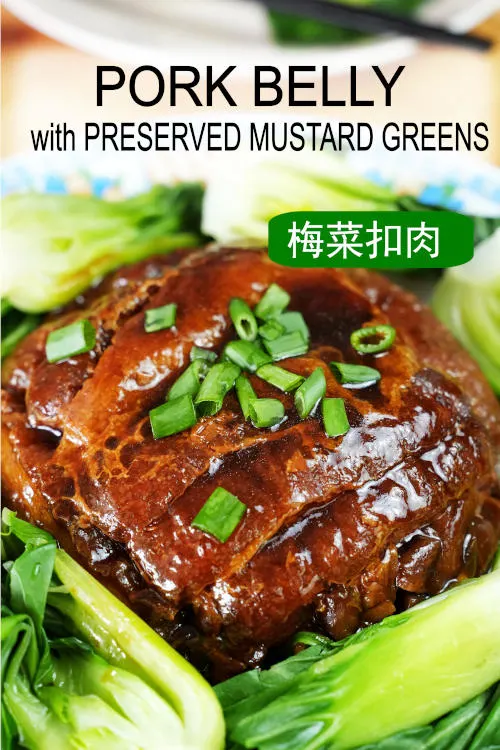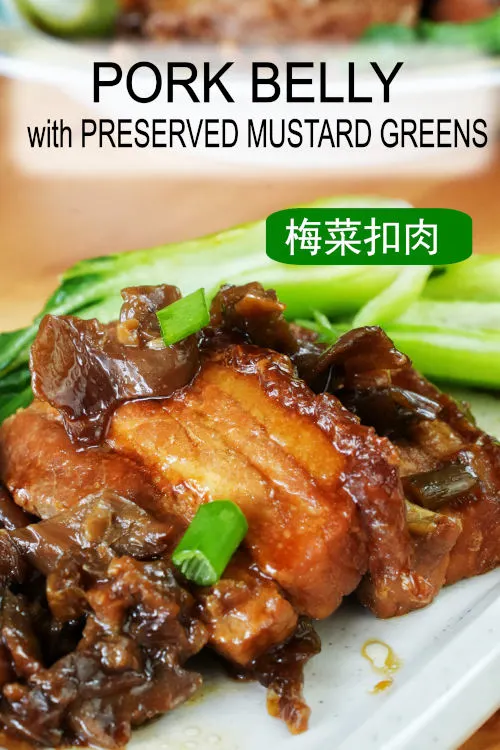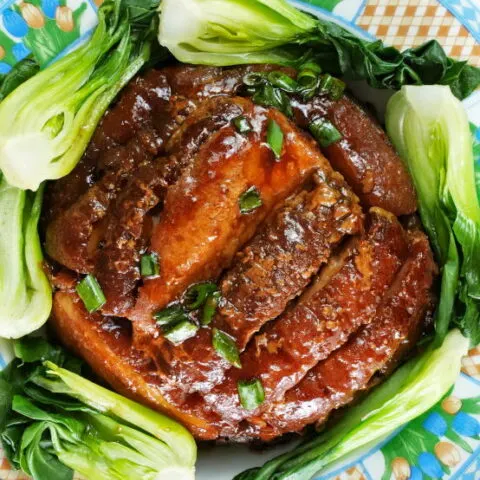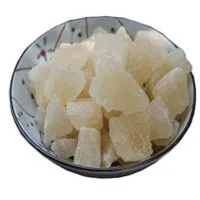Today I made a festive dish called pork belly with preserved mustard greens. It is called ‘mei cai kou rou / meicai kourou / 梅菜扣肉 in Chinese.
It is a dish I will only prepare during the festive season, and today is the 10th day of the Lunar New Year / Spring Festival.
Why do I make it during the festive season? First, it’s a popular dish served during the Spring Festival. But the main reason is that the preparation is tedious, and it’s best to make it when I am free during the holiday season.
The star of the dish is the preserved mustard greens, aka 梅菜 (méi cài). The flavor will be thoroughly infused into the pork belly, making it exceptionally tasty.
In this article, let me explain how to prepare this unique dish.

Note: This post may contain affiliate links. Please read my privacy policy for more info. I may receive commissions for purchases made through links in this post. As an Amazon Associate, I earn from qualifying purchases.
How to prepare Hakka-style pork belly with preserved mustard greens
As I mentioned earlier, this is not a quick and easy recipe. It involves braising and deep-frying the pork before steaming, and the preserved mustard needs to be washed thoroughly.
1. Preparation for the preserved green mustard
You can buy preserved green mustard from an Asian grocery store or wet market. It comes in two types: salty and sweet. I suggest getting both, but if you only use one, it is better to choose the sweet mei cai since it is also slightly salty.
Here are the steps to give it a pre-treatment before using it for cooking with other ingredients:
- Wash the preserved mustard green several times to remove the sand particles. You will notice some salt and sugar on the surface of the mustard green, which you have to wash away. Otherwise, the final result of the steamed pork belly will be way too salty, even if you do not add extra salt to the recipe.
- Cut off the root, which is fibery.
- Separate the leaves and wash them thoroughly.
- Change to water several times until the water is clear and clean.
- Soak the preserved mustard green in water for about fifteen minutes to remove more salt, as it can be too salty, especially if you use the salty type.
- Squeeze out the water, and cut the preserved mustard greens into small pieces about half cm.

2. Deep-fried the pork belly before steaming
- Clean the pork belly and remove any hairs on the skin with tweezers or burn them away with a blow torch.
- Preserve a pot of water enough to submerge the pork. Bring it to a boil.
- Add the ginger, spring onions, and Shaoxing wine.
- Place the cleaned pork belly in the water to blanch for 10 minutes.
- Remove the pork belly from the water. Then, poke multiple holes in the skin of the pork belly with a fork.
- Brush the skin with dark and light soy sauce.
- Place the pork belly on a wire rack to drain the excess liquid.
- Heat some oil in a flat bottom hand. Place the pork belly skin side down into the oil. Remember to put the lid on as it will splatter vigorously.
- Fried the skin until golden brown and turn crispy.
- Turn the pork belly over and deep-fry the other side for one or two minutes.
- When done, remove the deep-fried pork, place it, and let it return to room temperature.
Note:
- The purpose of blanching the pork with ginger, spring onion, and wine is to remove the unwanted porky smell.
- Pricking multiple small holes on the pork skin helps to make it crispy during deep-frying.
- Deep-frying the pork will add another layer of flavor to the pork.
3. Stir-fry the preserved mustard greens
- Saute the coarsely chopped garlic and ginger with oil until aromatic.
- Add the preserved mustard greens and continuously stir-frying.
- Season it with light soy sauce, dark soy sauce, rock sugar, white pepper powder, and Shaoxing wine.
- Add some water if it is too dry to stir-fry.,
- Do a taste test to ensure the flavor is balanced, then remove it from the wok.
Note: It is necessary to do a tasty test, especially if you use the salty mei cai alone, as it tends to be too salty. Some recipes also include oyster sauce and add star anise to flavor it. It is entirely your preference.

4. Steam the pork belly
- When the pork belly is cold enough to handle, cut it into 1 cm slices.
- Marinate the pork belly slices with light soy and dark soy sauce for half an hour.
- Arrange the pork slices in a bowl, skin side down, in a bowl. Secure it with two pork slices on both sides.
- Spread the mei cai mixture on top of the pork slices, and fill up all the crevices in the bowl.
- Press it lightly with your hand or with the back of a spoon to ensure that the preserved mustard greens and pork slicers are firmly positioned.
- Pool the remaining marinade into the bowl.
- Set up a steaming station. I used a steamer set made specifically for this purpose.
- Steam the pork belly and the preserved mustard greens over low-medium heat for two hours. Please remember to add some hot water occasionally to ensure it will not dry out.
5. The final touch
- Remove the pork belly from the steamer after steaming for two hours.
- When it is cold enough to handle, remove the liquid inside the bowl and place it into a pan.
- Thicken it with some cornstarch slurry to form a gravy.
- The final dish should be served upended. Cover the bowl with a serving plate and turn it over.
- Drizzle the gravy onto the pork to serve.
- Garnish with spring onion or coriander leaves. It is best to swerve with steamed rice.
The pork is now so tender that it will separate easily from the chopsticks. In addition, the flavor and aroma of the preserved green mustard have been thoroughly infused into the meat.
It takes a bit of time to prepare, but it’s worth the time and effort.
About the preserved mustard green
梅菜 (méi cài in Mandarin, mui choy in Cantonese, Meigan cai) means “preserved mustard greens” or “pickled mustard greens” in English. It can be quite confusing as some translations of 梅菜 as a preserved vegetable. There are a few types of preserved vegetables used in Chinese cuisine, namely 梅菜, 咸菜, 榨菜, 大头菜, 碎米芽菜, which have different tastes. Since there are different types of preserved vegetables, it is better to term 梅菜 as preserved mustard green.
The flavor of preserved mustard greens is tangy, salty, and just a bit sour. It frequently serves as a condiment in Chinese cooking, especially meat dishes, adding a burst of umami-rich taste. The texture of mustard greens is crisp, and the leaves are chewy.
There are two types—the salty and sweet types. I use a mix of both in this recipe, but if I decide to use only one type, I will choose the sweet type since, besides sugar, it is also important in the preservation process.
How to make preserved mustard greens?
The Chinese mustard greens (芥菜) are pickled in a brine solution with coarse salt, rice wine, ginger, and garlic. They are cleaned and packed into large clay urns. The brine is added to the mustard greens, and the jars are sealed. The mustard greens will start to develop a unique flavor after several weeks. You may now utilize the fermented preserved mustard greens in recipes.
Other related recipes for you
- Here is another pork belly recipe for you. It is similar to this article’s recipe but steamed with taro instead of pickled mustard green.
- Another version of the braised pork belly is called 红烧肉, or ‘red-cooked pork’ in Chinese. The meat is braised with a range of spices until it attains the melt-in-the-mouth texture.

Mei Cai Kou Rou - How to prepare pork belly with preserved mustard greens
Try Mei Cai Kou Rou, the savory Chinese pork dish with preserved mustard greens for
a delightful aroma and taste.
Ingredients
- 150g sweet preserved mustard green
- 150g salted preserved mustard green
- 1kg pork belly
- 4 pieces of ginger
- 2 tbsp of Shaoxing wine
- 2 tbsp of cooking oil
- 2 tbsps coarsely chopped garlic
- 1 tbsp coarsely chopped ginger
- 2 tbsps light soy sauce
- 2 tbsp dark soy sauce
- 1/4 tsp white pepper powder
- 2 tbsp Shaoxing wine
- 2 tbsp rock sugar
Instructions
For the preserved green mustard
- Cut off the root, separate the leaves, and wash them thoroughly.
- Change to water several times until the water is clear and clean.
- Soak it in water for about fifteen minutes to reduce its saltiness.
- Cut the preserved mustard greens into small pieces about half cm.
- Saute the coarsely chopped garlic and ginger with oil until aromatic.
- Add the preserved mustard greens and continuously stir-frying.
- Season it with light soy sauce, dark soy sauce, rock sugar, white pepper powder, and Shaoxing wine.
Deep-fried the pork belly before steaming
- Bring the water to a boil.
- Add the ginger, spring onion (green onion), Shaoxing wine, and pork. Blanch for 10 minutes.
- Remove the pork belly from the water. Then poke multiple holes in the skin side with a fork.
- Brush the skin with dark and light soy sauce, then drain the excess liquid on a wire rack.
- Deep-fry the pork belly skin side down into the oil. Remember to put the lid on as it will splatter vigorously.
- Fried the skin until golden brown and turn crispy.
Steam the pork belly
- Cut the pork into 1 cm slices.
- Marinate the pork slices with light soy and dark soy sauce for half an hour.
- Arrange the pork slices in a bowl, skin side down. Secure it with two pork slices on both sides.
- Spread the preserved mustard greens on top of the pork slices, and fill up all the crevices in the bowl.
- Press it lightly with your hand to ensure that the preserved mustard greens and pork slicers are firmly positioned.
- Pour the remaining marinade into the bowl.
- Steam the pork belly and the preserved mustard greens over medium heat for two hours.
The final touch
- After steaming, remove the liquid from the bowl and place it into a pan.
- Thicken it with some cornstarch slurry to form a gravy.
- Cover the bowl with a serving plate and turn it upend.
- Drizzle the gravy onto the pork to serve.
- Garnish with spring onion or coriander leaves to serve.
Recommended Products
As an Amazon Associate and member of other affiliate programs, I earn from qualifying purchases.
-
 Helen Ou @ Guangxi Specialty: Traditional Pure Brown Rock Sugar 17.6oz
Helen Ou @ Guangxi Specialty: Traditional Pure Brown Rock Sugar 17.6oz -
 Butane Torch Kitchen Blow Lighter - Culinary Torches Chef Cooking Professional Adjustable Flame with Reverse Use for Creme, Brulee, BBQ, Baking, Jewelry by FunOwlet (Butane Fuel Not Included)
Butane Torch Kitchen Blow Lighter - Culinary Torches Chef Cooking Professional Adjustable Flame with Reverse Use for Creme, Brulee, BBQ, Baking, Jewelry by FunOwlet (Butane Fuel Not Included) -
 Oster Steamer Stainless Steel Cookware, 3.0-Quart
Oster Steamer Stainless Steel Cookware, 3.0-Quart
Nutrition Information:
Yield: 4 Serving Size: 1Amount Per Serving: Calories: 878Total Fat: 62gSaturated Fat: 20gTrans Fat: 1gUnsaturated Fat: 40gCholesterol: 210mgSodium: 1649mgCarbohydrates: 14gFiber: 2gSugar: 7gProtein: 61g
This data was provided and calculated by Nutritionix on 03/02/2024

Jean Hagley
Monday 6th of February 2023
Hi KP Kwan, Thank you for your braise pork knuckle recipe. I tried it today and everything turned out really well except the pork knuckle meat was a bit dry. The skin and fat was gorgeously gelatinous. I suspect the grade of pork knuckle I bought was not good. Reading your latest pork belly recipe with Mui Choy has given me and idea. Maybe steaming the pork knuckle first would soften the whole knuckle, not only the skin but the meat fibres too.
KP Kwan
Monday 6th of February 2023
Hi, this is KP Kwan. I am happy to see you in this comment area, as you have read through my recipe. I am glad to reply to any questions and comments as soon as possible.
Elsa
Monday 6th of February 2023
@KP Kwan, Thank you! Looks delicious. Another way to prepare pork belly. Elsa